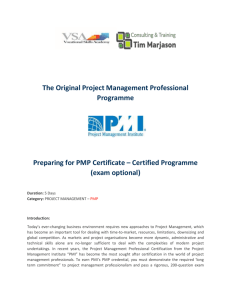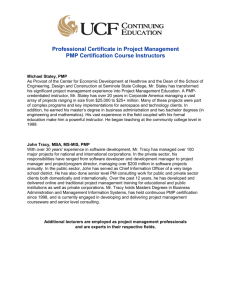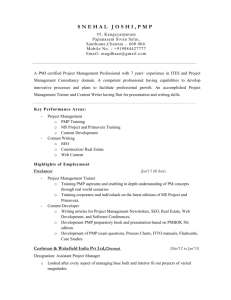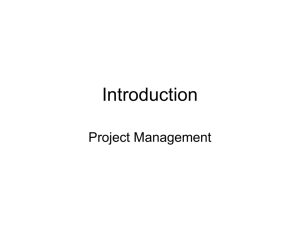The project management processes selected by the project
advertisement
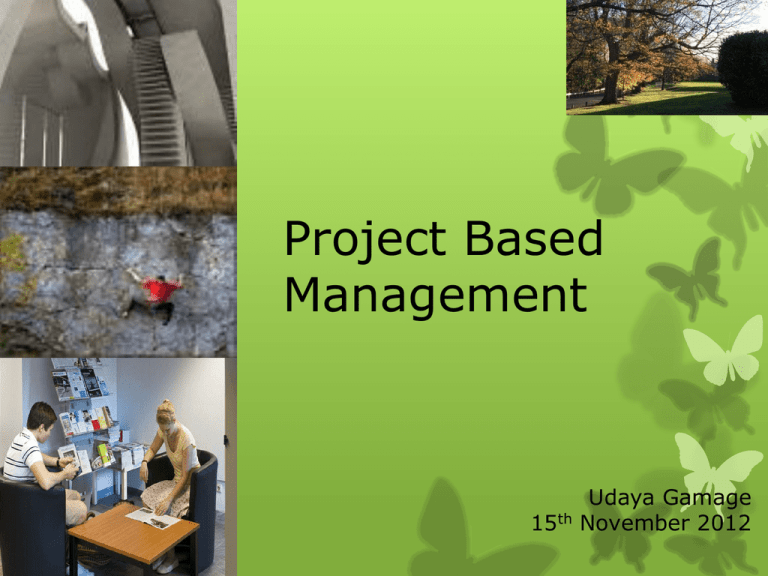
Project Based Management 15th Udaya Gamage November 2012 Description Marks out of Weighted average Due Date Assignment 1 100 5 28 Nov. 2012 Assignment 2 100 30 24 Dec. 2012 Assignment 3 100 65 4 Feb. 2012 Assignment 1 Provide the following (no mark sheet is required) Cover sheet (showing student details, etc) Title or name of project Brief background of the project (100 words approximately) Explanation of the project status. •Is the project completed? •Is it under way? •Or is it yet to start? This is important in terms of your critical analysis in assignments 2 and 3 (50 words) Justification of why the selected project is suitable for analysis of the topics in assignments 2 and 3 (50 words approximately) Confirmation that you have a PMP available for analysis in assignment 3. Assignment 2 Topic: The Project Business Case Word Length – 2500 approximately The cover or title page should have the following Title author date student number Executive summary 100 -200 words (does not form the part of assignment count) Why the report was prepared How it is structured what are the important findings conclusions and recommendations Assignment 2 Table of contents (respective page numbers of) executive summary Introduction Main sections References Individual appendices Figures and tables Introduction 100 Words Why the report has been prepared What project is being analyzed How the report is structured Assignment 2 Project Background 100 words approximately Brief background of the project context Business case (should provide) Justification for undertaking a project Evaluating the benefits, cost and risk of alternative options and the rationale for the preferred solution Provide a critical analysis of the business case for your chosen project to cover the points below. In what ways does your project conform (or not) to the definition of a project in the literature? Who (or what) is the ‘sponsor’ of your project? To what extent was a ‘business case’ created for this project (or should have been)? In what ways are the benefits, cost and risk evaluated as part of the business case (or should have been)? In what way/s is the preferred solution justified (or should have been)? In what way is management commitment and approval for the investment obtained (or should have been)? Assignment 2 Conclusions 150 words approximately Lessons learned What findings are important for the management in future projects What represent a threat to project success Recommendations 150 words approximately How your project (or similar future projects) should be managed in light of what you have learned from your analysis. Assignment 2 List of references – (using the Harvard AGPS system) There should be at least 15 references Use the e-Journals and eBooks available from the library website Appendices Turnitin Originality Report Assignment 3 Topic: The Project Management Plan Word Length 3000 – 4000 approximately Consists of two parts body of the assignment and is a critical analysis of the chosen PMP Appendix 1 which should be a practical Project Management Plan The cover or title page should have the following Title author date student number Assignment 3 Part 1: Critical Analysis of the Project Management Plan Executive summary 200 -250 words (does not form the part of assignment count) Why the report was prepared How it is structured what are the important findings conclusions and recommendations Assignment 3 Table of contents (respective page numbers of) executive summary Introduction Main sections References Individual appendices Figures and tables Introduction 250 Words Why the report has been prepared What project is being analyzed How the report is structured Assignment 3 Project Background 250 words approximately Brief background of the project context Structure and the contents of the PMP 1000 – 1500 approximately Provide a critical analysis of who is intended to be the main audience of the PM plan? What do they need to know? How will they use the plan? What information needs to be provided? How should that information be provided? In what sequence? What does the theory say? What alternatives exist for the structure of a PM plan (examine and compare a range of theories and opinions here)? Assignment 3 Provide a critical analysis of how the PM plan has been structured relative to what theory suggests Justify why the respective components have been included or explain why it should have been structured differently. Contents of the PMP 1000 – 1500 words Why has a project schedule been included? Is it a meaningful document Was it prepared by the right people, does it contain the right information, etc.? Assignment 3 Conclusions 250 words approximately Summarize your findings from the analysis of your project management plan What did you find out about the project plan? Does it conform to the recognized theory? What aspects are important and are of significance to project outcomes? What are its strengths and its weaknesses? Assignment 3 Recommendations 250 words approximately What are your recommendations flowing from this analysis with regard to the PMP? What changes should be made to the PMP for this project (or similar future projects)? Address the shortcomings identified in the conclusions focus on recommendations related to the PMP and not on the project itself. List of references Appendices Assignment 3 Part 2: Appendix 1 – The PMP Should include the following project background, including an overview, brief description and a statement of objectives of the project a summary of the management approach to be taken, who will manage the project, to whom do they report, how will project governance be achieved, etc. detailed sections on the various aspects of the project that need to be managed (scope, time, cost, etc.) additional information or documents to support the above Turnitin Originality Report What is a project? Unique Novel Transient How do you differentiate this with normal business? delivering objectives with constraints of time, cost, and quality What is a temporary organization in PM? Ex. of supertanker and flotilla of Yachts How can we categorize projects? Runners, Repeaters, Strangers, and aliens What is the difference between the outcome/output of a project and the desired performance improvement? Ex, of A bridge across the Yangtze river What do you think about the owner contractor model in a project? Core functions of PM (+ 2, risk and commitment of stakeholders need to be managed) Study table 1.2 of turner for tools and techniques of PM Scope managed thro’ product breakdown structure Organization managed thro’ organization breakdown structure Quality managed thro’ control techniques Cost is managed thro’ cost breakdown structure Time managed thro, networks and bar charts (CPA, CPM, and PERT) Management of the project second dimension of the structured approach The project life cycle (stages thro’ vision to reality)) The management process (management of stages Five steps of the cycle Concept Feasibility Design Execution Close-out Management process is derived from the ten step problem solving cycle (refer table 1.4 and figure 1.6) The management process (each stage of the PM to be executed) Project Management is Fractal management, Discuss? The levels, third and final dimension the integrative level, (project definition report, functional design, and flow chart) The strategic and administrative level (milestones, responsibilities, and the system design) The tactical or operational level ( activity schedule, responsibility chart, and detailed design) Read on project management as sailing a Yacht Micro-level Macro-level Objectives Define the steps and processes necessary to move the project forward from a conceptual idea to a meaningful change management project Develop an initial project charter for sponsor decisionmaking so that more detailed investigations can be undertaken Develop business cases necessary to ensure the project is consistent with the sponsor’s objectives and goals Define the scope and nature of the proposed project to allow more detailed planning to take place for sponsor commitment. Figure 3.1: Project management process interactions (Source: PMI 2008, p. 42) The project charter The three Ws – why, what and when The three Hs – how much, hazards and how The four Cs – critical success factors, communication plan, collection of knowledge and commitment. The business case What the project is Why it should be done What options have been considered? How much will it cost? How will it be done? What are the risks? Gambles (2009) provides some clear guidelines on the purpose of a business case and how to go about it. Confirm that the business case is robust – that is, in principle it meets business need, is affordable, achievable, with appropriate options explored and likely to achieve value for money. Establish that the feasibility study has been completed satisfactorily and that there is a preferred way forward Ensure that there is internal and external authority, if required, and support for the project. Establish that quality plans for the project and its products are in place Ensure that the major risks have been identified and outline risk management plans have been developed. Establish that the project is likely to deliver its business goals and that it supports wider business change, where applicable. Confirm that the scope and requirements specifications are realistic, clear and unambiguous. Ensure that the full scale, intended outcomes, timescales and impact of relevant external issues have been considered. Ensure that there are plans for the next stage. Confirm planning assumptions and that the project team can deliver the next stage. Confirm that overarching and internal business and technical strategies have been taken into account. Stephen Wearne’s life cycle for industrial projects Several versions of the project life cycle set the project within the life cycle of the product Refer fig. 11.1 and table 11.1 project life cycle used by the World Bank Harold Kerzner Proposes a model addressing the life cycle of the product produced by the new asset – classical marketing view Refer fig. 11.2 Where are we now? The Business Case completed Articulated the project brief or Charter to key sponsors Developed guidelines and constraints (risks) What is next? Firm expectations of the key sponsors will result on What the outcome will be When it will be delivered How it will be delivered Who will deliver it What resources will be consumed What benefits will be delivered So the next stage is to plan to deliver the Business Case What should we do in the planning stage? Define organizational unit that have project responsibility What finances that organization can afford What processes will take place to ensure that the project happens with the least fuss and the least exposure to risk How the end benefits will be measured to demonstrate project success or failure PMP Inputs required to create a comprehensive project management plan (PMP) What processes must be undertaken What the outcomes provide for further decisionmaking and implementation purposes What is planning phase? Initiating a good idea into a final out come Project integration steps – a scalable methodology guide (Planning Inputs) Area ( major investment, significant investment, moderate investment, minor investment) Project Charter (define responsibilities, describe specific objectives, express commitments of staffing, etc.) Life Cycle Phase and Milestones (define event based management, link them to final deliverables etc.) Project Stakeholders (prepare and update a structured stakeholder analysis, quality management plan, risk management plan etc.) The Project Plan (produce an integrated family of documents defining project activities) Project Management Methodology (prepare PMP describing methodology, reviews, baseline controls etc.) Planning Process Gray and Larson (2000) provide some guidelines for the PMP development process as follows: Important planning decisions are made when answering the following project-related questions: How will the project plan be developed? Who will develop the project plan, and how involved will the customer be? What project management software package will be used, if needed? Who on the project team will be responsible for entering the planning information? Who will have input on the plan? What specifically are the roles and responsibilities of each team member? How will team members be informed of decisions? Understanding that cost, time, and quality (performance) are all important, what are the priorities? What are the deliverables of the project planning process? What format is appropriate for each of these deliverables (e.g., milestone charts) Who will approve and certify at the completion of each deliverable? Who receives each deliverable Planning Outcomes Project Management Plan PMP provides information How the project will be managed, as well as How the product or service itself will be produced PMP is a document used to Guide project execution Document project planning assumptions Document project planning decisions Facilitate communications among stakeholders Define key management reviews as to content, extent, & timing Provide a baseline for progress measurement & project control. Contents of PMP (Barkley, 2000 suggests) Control points, for instance, stage-gateway reviews, to ensure that management authorizes movement from one phase or stage to another reporting and monitoring strategies, including the use of earned value to integrate cost, schedule, and quality performance, which should be made explicit The project management processes selected by the project management team The level of implementation of each selected process The descriptions of the tools and techniques to be used for accomplishing those processes How work will be executed to accomplish the project objectives How changes will be monitored and controlled How configuration management will be performed How integrity of the performance measurement baselines will be maintained and used The need and techniques for communication among stakeholders The selected project life cycle and, for multi-phase projects, the associated project phases Key management reviews for content, extent, and timing to facilitate addressing open issues and pending decisions. How the selected processes will be used to manage the specific project, including the dependencies and interactions among those processes, and the essential inputs and outputs PMP may include in summary Project scope management plan Schedule management plan Cost management plan Quality management plan Process improvement plan Staffing management plan Communication management plan Risk management plan Procurement management plan. Structure of PMP Overview or executive summary – a brief description of the project and its deliverables, and a list of major milestones Objectives – a detailed description of the project’s deliverables and outcomes, (Mission Statement) General approach – where technical and managerial approaches are defined Contractual - where the procurement process is described, and the specific legal aspects defined Schedule – an outline of all schedules and milestones, using an action plan based on a WBS Resources – estimates of capital and operating expenses. Personnel – describing the project work force, and requirements for special skills, expertise etc. Evaluation methods – describing evaluation methods and standards for the completed project. Potential problems – identifying any likely risk events that could adversely affect the project. Hard Skills of Project management Scope may be defined Product breakdown structure (a cascade of products, subproducts, assemblies and components) Organization breakdown structure (a cascade of resource types, skill types or activities Work breakdown structure (a cascade of the products and work activities),and/or Some other form which comprehensively defines products and activities

